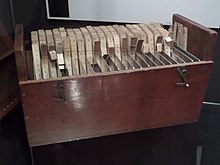
Beevers–Lipson strips were a computational aid for early crystallographers in calculating Fourier transforms to determine the structure of crystals from crystallographic data, enabling the creation of models for complex molecules. They were used from the 1930s until computers with enough power became generally available in the 1960s.
The technique was developed by C. Arnold Beevers (1908–2001), reader in crystallography at the University of Edinburgh, and Henry Lipson CBE FRS (1910–1991), Professor of Physics at the University of Manchester Institute of Science and Technology. The approach converted the sizable calculations of multi-dimensional Fourier summations needed in crystallography analysis into sums of more manageable one-dimensional values. The folded card strips with numbers were typically stored in two wooden boxes, one for sines and one for cosines. Previously it was necessary to consult sine/cosine tables, a time-consuming process. The approach was used by the Nobel Prize winner Dorothy Hodgkin OM FRS (1910–1994). The technique is still used in modern computer programs.
See also
References
- ^ "Set of Beevers Lipson Strips, Sine Set, c.1936". Oxford: Museum of the History of Science. Retrieved 28 March 2014.
- Beevers, C. A.; Lipson, H. (1985). "A Brief History of Fourier Methods in Crystal-structure Determination". Australian Journal of Physics. 38 (3): 263–271. Bibcode:1985AuJPh..38..263B. doi:10.1071/ph850263.
- ^ Gould, Bob (December 1998). "The mechanism of Beevers–Lipson strips". BCA Newsletter. International Union of Crystallography. Retrieved 28 March 2014.
- "Cecil Arnold Beevers" (PDF). Crystallography News. Royal Society of Edinburgh. 2001. Archived from the original (PDF) on 29 March 2014. Retrieved 28 March 2014.
- "Beevers–Lipson strips in oak case". Collection of Historical Scientific Instruments. USA: Harvard University. Archived from the original on 29 March 2014. Retrieved 28 March 2014.
- Hodgkin, Dorothy Crowfoot (11 December 1964). "Nobel Lecture: The X-Ray Analysis Of Complicated Molecules". Chemistry, Nobelstiftelsen. Amsterdam: Elsevier. pp. 70–94. Retrieved 28 March 2014.
- November, Joseph A. (2012). Biomedical Computing: Digitizing Life in the United States. Johns Hopkins University Press. p. 30. ISBN 9781421404684. Retrieved 28 March 2014.